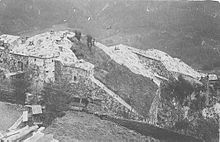Corno plant
The Corno plant was a fortress in the Austro-Hungarian fortress bar on the then imperial border with Italy .
location
It is located southwest of the village of Lardaro in the Valle del Chiese ( Trentino ) and belonged to the Lardaro barrier group. The plant is now in the territory of the municipality of Valdaone .
History and description
The Corno plant was the first of the four plants belonging to the Lardaro blocking group to be started in 1883 and completed in 1890. The fort is located on the front slope on the west side of the valley and blocked access to the north. The plant was six minimum chart guns 12 cm M 80 and three tank mortars 15 cm M 80 (later against three armored howitzers 10 cm M 5 exchanged) exceptionally strong armed. In addition, there were originally five 11 mm mitrailleuses in the inventory, but these were replaced by eight MG 07/12 machine guns at the beginning of the war . The enclosed space was 18,000 cubic meters, there were 53 rooms. Because of the location on a rock nose, no surrounding trench was necessary, only the throat was secured by a neck trench .
It was listed in quarry stone masonry, which in 1914 only led to a classification as bomb-proof and storm-free (the structure would not have been able to withstand prolonged bombardment of guns with a caliber of 15 cm and higher). Due to the hillside location, the facility was laid out in three stages and adapted to the geographical conditions. Two steps known as the south battery had been built one above the other in a south-south-west direction; another, known as the east battery, was presented to the south-southeast.
When the war began in 1915, the guns were dismantled and used in field positions. The two self-propelled howitzers were then in an artillery position built for this purpose above the plant.
During the war, the attackers paid little attention to the completely outdated structure, so that it has remained largely undamaged. After it fell into disrepair over the years, it was bought in 1997 by the municipality of Praso , which commissioned a project to secure and restore the building. In the period that followed, the factory was restored and the original, now demolished, pure zinc roof was also reconstructed. Since 2014 the Corno plant has been open to visitors again in the summer months.
Web links
- Information and images on the restored Corno work in Italian , accessed on March 21, 2017.
literature
- Vittorio Carrara, Michela Favero (eds.): Le montagne dei forti. Paesaggi alpini e architetture militari nell'alta valle del Chiese. 1859-2014 , Fondazione Museo storico del Trentino, Trento 2014.
- Maurizio Dallavalle, Michela Favero: Forte Corno. Paesaggio in trasformazione in: Provincia Autonoma di Trento - Soprintendenza per i Beni Culturali - Ufficio Tutela e Conservazione dei Beni architettonici (ed.): Il recupero dei forti austroungarici trentini , Provincia Autonoma di Trento, Trento 2014.
- Erwin Anton Grestenberger: Imperial and Royal fortifications in Tyrol and Carinthia 1860–1918 . Verlag Österreich ua, Vienna 2000, ISBN 3-8132-0747-1 .
References and comments
- ↑ In addition to Corno, the Lardaro barrier also included the Larino, Danzolino, Carriola and Revegler roadblocks.
- ↑ On January 1, 2015, Praso merged with the parishes of Daone and Bersone to form the parish of Valdaone.
- ↑ Information, opening times and images on Corno's work in Italian, German and English, accessed on March 21, 2017.
Coordinates: 45 ° 57 ′ 45 " N , 10 ° 38 ′ 49" E

